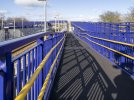telstarbox
Established Member
An interesting article in the Guardian about four pre-fab systems used by British Rail / Network Rail: Mod-X on the Styal Line, Clasp on the Southern Region, D70 around the south east, and two newer systems in the NR era.

 www.theguardian.com
www.theguardian.com

Station to station: a spotter’s guide to prefab design on the railways
As a national conversation is launched about the future of local station design, we explore the wonders of prefab design on the railways








